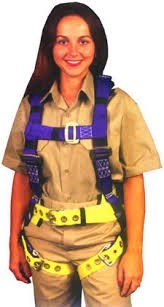Use Of A Safety Harness

Safety harnesses are a necessary piece of equipment that prevent injuries on the job, in sports and daily activities. The use of safety harnesses saves thousands of lives each year. However, there are some little known dangers that can make a safety harness just as lethal as not using one. Increasing the safety of a harness often requires due diligence and a team effort.
Identification
No standard safety harness, also known as a restraining harness and safety vest, exists. Anything that tethers an individual to a stationary object acts as a safety harness. Seat belts are a commonly used harness, according to the National Association of State Directors of Public Transportation Services.
Function
Many occupations and recreational activities use safety harnesses. Construction workers and rock climbers use a harness to prevent injuries from falling, report Bill Weems and Phil Bishop of the Electronic Library of Construction Occupational Safety and Health. Seat belts prevent small children from moving around in a car and protects drivers in case of a crash.
Significance
The National Highway Transportation and Safety Administration reports that automobile seat belt harnesses prevent about 15,000 deaths each year, including the lives of 425 children in 2006. Approximately 5,441 people involved in car crashes die each year because they do not wear a seat belt. Using a seat belt in conjunction with an air bag saves an average of 2,500 extra lives each year.
Misconceptions
While harnesses save many thousands of lives each year, they can also be harmful in some circumstances, reports eLCOSH. Harness use in high altitude jobs, such as construction or work in shafts, sometimes cause what is known as harness trauma. The effects of harness trauma are similar to those that occur when you stand for long periods of time. Blood pools in the legs and thighs, reducing blood flow to the heart.
Prevention/Solution
Preventing the dangers from the use of a safety harness requires vigilance by supervisors and coworkers. When using a harness to prevent falling, always have another person lowering the rope and frequently checking the consciousness of your coworker. When suspended in a harness, move legs around to increase blood flow. Seat belts are often required for children under 50 to 60 pounds.
Identification
No standard safety harness, also known as a restraining harness and safety vest, exists. Anything that tethers an individual to a stationary object acts as a safety harness. Seat belts are a commonly used harness, according to the National Association of State Directors of Public Transportation Services.
Function
Many occupations and recreational activities use safety harnesses. Construction workers and rock climbers use a harness to prevent injuries from falling, report Bill Weems and Phil Bishop of the Electronic Library of Construction Occupational Safety and Health. Seat belts prevent small children from moving around in a car and protects drivers in case of a crash.
Significance
The National Highway Transportation and Safety Administration reports that automobile seat belt harnesses prevent about 15,000 deaths each year, including the lives of 425 children in 2006. Approximately 5,441 people involved in car crashes die each year because they do not wear a seat belt. Using a seat belt in conjunction with an air bag saves an average of 2,500 extra lives each year.
Misconceptions
While harnesses save many thousands of lives each year, they can also be harmful in some circumstances, reports eLCOSH. Harness use in high altitude jobs, such as construction or work in shafts, sometimes cause what is known as harness trauma. The effects of harness trauma are similar to those that occur when you stand for long periods of time. Blood pools in the legs and thighs, reducing blood flow to the heart.
Prevention/Solution
Preventing the dangers from the use of a safety harness requires vigilance by supervisors and coworkers. When using a harness to prevent falling, always have another person lowering the rope and frequently checking the consciousness of your coworker. When suspended in a harness, move legs around to increase blood flow. Seat belts are often required for children under 50 to 60 pounds.
- 8n6beb508e93830e15b78ccec031c5856e.jpg